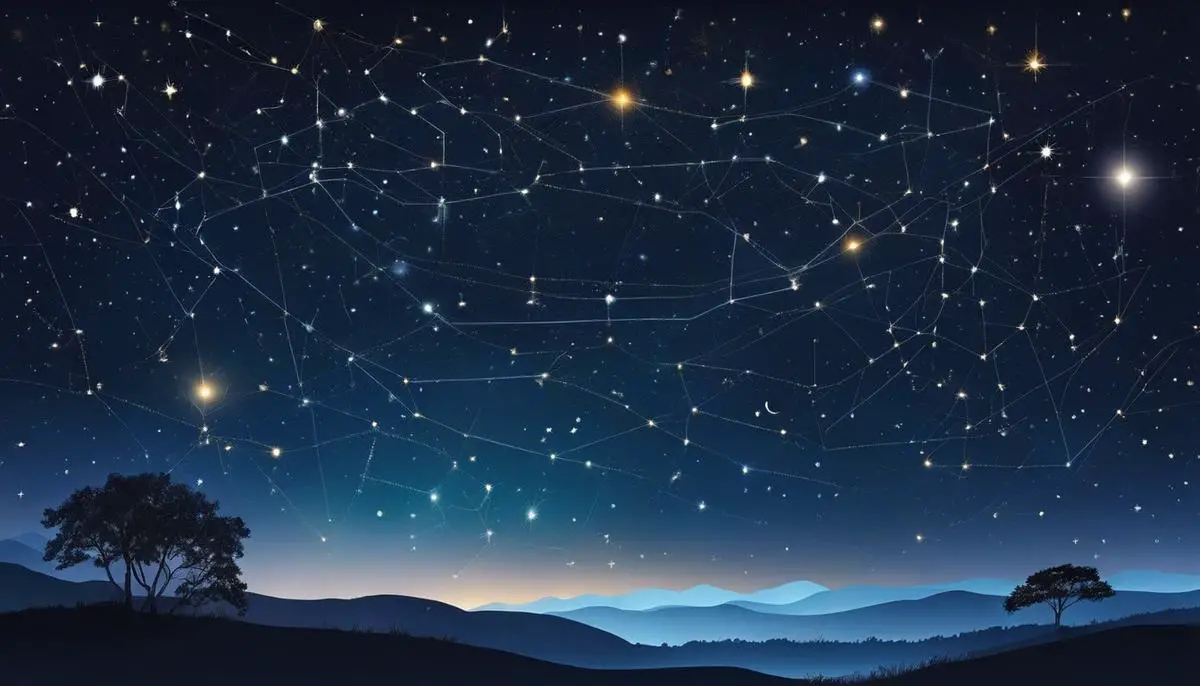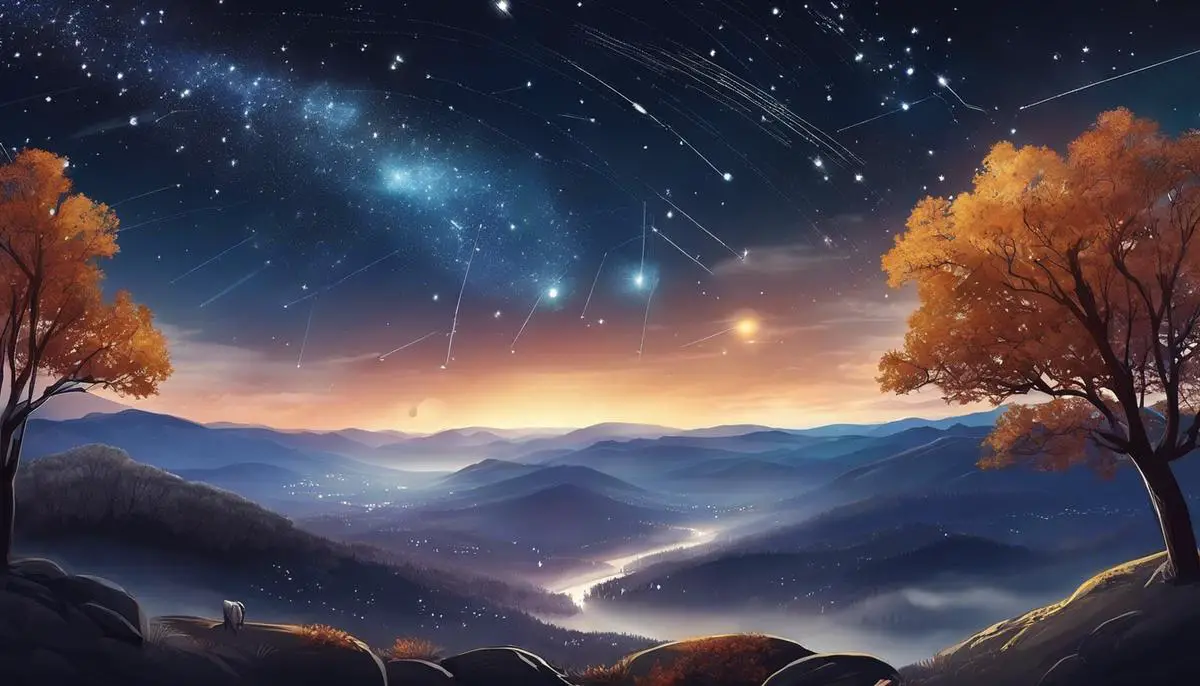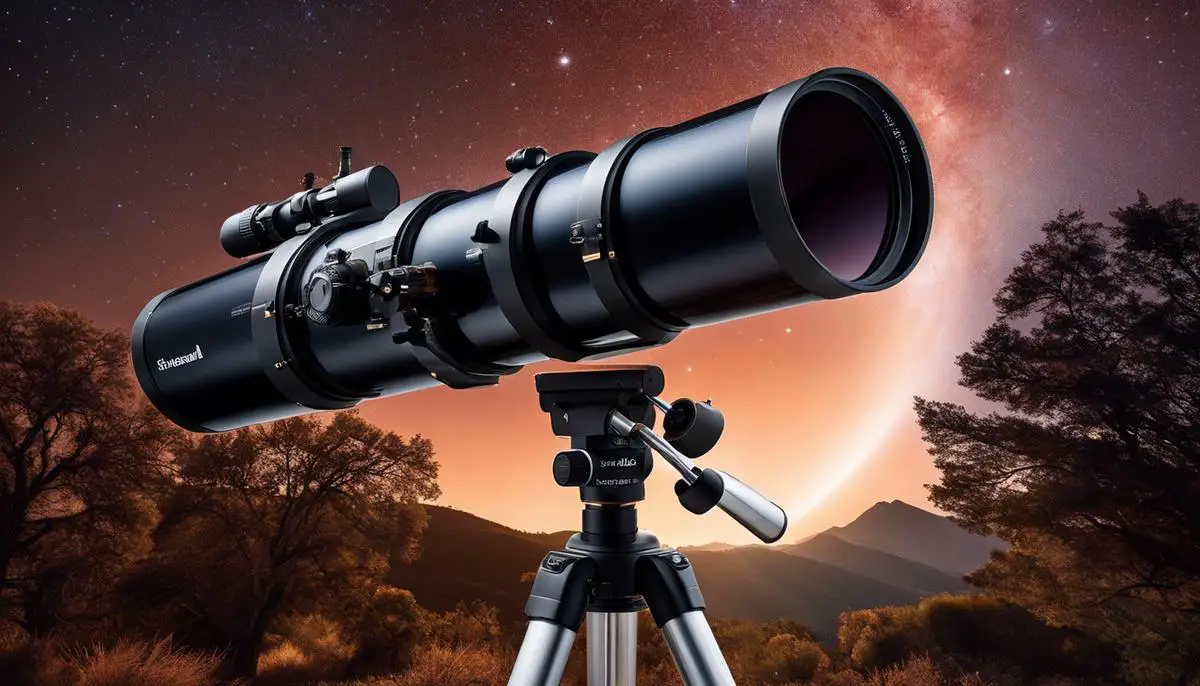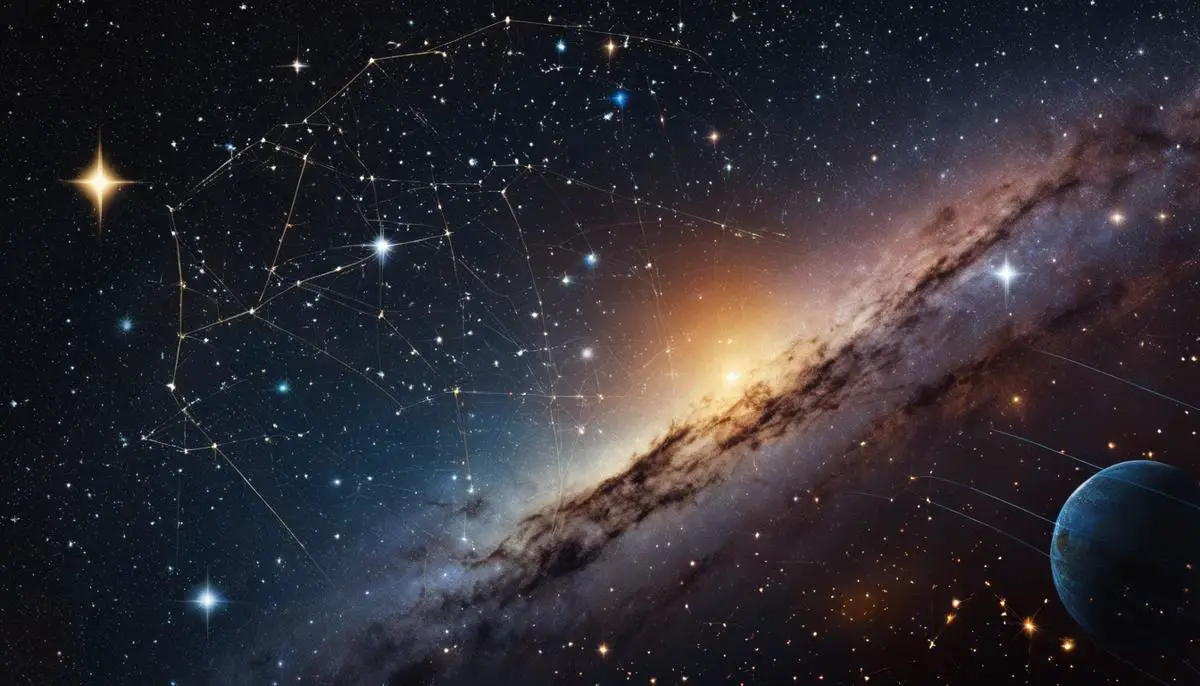The vast cosmos stretches beyond our imaginations, dancing with constellations that have been subjects of fascination, research and interpretation for millennia. As we stand on the brink of November 2023, our night sky prepares to paint its canvas with unique patterns of stars and galaxies, reminding us of the timeless beauty concealed within the universe. This discourse delves into understanding these magnificent constellations, grounding its narrative in their origins, significance and the techniques to conduct their observations. As we explore, we weave the tales of these celestial bodies in the tapestry of history and culture, while touching upon the scientific foundations they stand upon and the advancements in astronomical research that they stimulate.
Understanding Constellations
A Gaze into the Night Sky: The Science and Historical Impact of Constellations
In tracing the bond between humanity and the cosmos, an indispensable motif emerges: constellations. These celestial configurations have been imagined, depicted, and studied for millennia, embodying a veritable blend of scientific relevance and historical ensign.
On the scientific front, constellations are not random collections of stars, as might appear to the untrained eye. Instead, they represent designated areas of the night sky, each encompassing a unique cluster of stars. The paradigm of 88 modern constellations, adopted by the International Astronomical Union in 1922, is based on the work of classical astronomers.
Stars within constellations, while appearing to maintain close relative distances, are typically disparate in their actual spatial placements. This celestial illusion of proximity is caused by the inevitable restriction of viewing space in two dimensions from our Earthly vantage point. The actual distances separating these stars can range from a few to several thousands of light years, reflecting the unfathomable expanse of our universe.
On a larger universal scale, constellations serve as our cosmic GPS, allowing astronomers to map the night sky, distinguishing one region from another. Within a constellation, individual stars may vary in properties like size, luminosity, and temperature, making them intriguing objects of study for stellar astrophysics.
Crucial as they are to scientific exploration, constellations also bear an immense historical significance, etched deeply into the cultural narrative of countless societies. They were vital navigational tools for ancient mariners, timekeepers for farmers, and a source of myth and legend that attempted to explain the world’s creation and functioning.
In Ancient Greece, constellations were seen as divine manifestations, each with its unique mythological narration. Significantly, beings like Hercules, Andromeda, or mythical creatures such as Pegasus, all found representation among the stars. These celestial narrations were not exclusive to Greece. Civilizations such as those of the Indigenous Australians, Chinese, and Mayans too wove their unique constellation stories, providing glimpses into their cultural, spiritual, and societal ethos.
The procession of the constellations throughout the year also allowed early societies to develop accurate calendars, marking seasons, and guiding agricultural practices. This scientific application of constellations holds relevance even today, putting the cycles of nature in celestial perspective.
In summary, the constellation is the beautiful continuum of science and history that connects us, across time and space, to the stars. This tapestry of twinkling points has been humanity’s canvas of curiosity, wonder, and ingenuity, painting a rich history of our shared existence amidst a universe of astounding scale and complexity. Through the knowledge of constellations, we not only delve into the intricacies of our universe, but we also preserve countless tales and relics of our collective past, embodying an astute comprehension of our place in this cosmic panorama.
In the vast expanse of the universe, constellations remain our points of intimate connection, an age-old celestial journal mapping humanity’s journey, both scholarly and spiritual, that’s written in the language of stars. With each gaze into the night sky, we further this ongoing narrative, embracing cosmic beauty, scientific exploration, and our shared human heritage.

Notable November Constellations
November 2023 is set to host a spectacle in the celestial sphere that has astronomers fervently poised with their telescopes. The constellation patterns that grace our skies during this month hold both subtle beauty and notable scientific significance, presenting distinctive features that set them apart from those in other months.
A rather special celestial interplay will occur between Pegasus and Andromeda, two adjacent constellations known for their proximity to each other. Pegasus, the great winged horse of mythology, will be at its zenith in the Northern hemisphere. Directly connected to Pegasus through the shared star Alpheratz, Andromeda will rise higher in the sky, enabling enhanced visibility for observers. This makes November an opportune time for star spotters.
This tandem appearance of Pegasus and Andromeda is a significant astronomical phenomenon as it enables opportunities for observational astronomy. The combined sky coverage of these constellations hosts a diverse range of celestial objects, granting astronomers access to study various star types and celestial phenomena. Notably, the Andromeda galaxy, our closest spiral galaxy neighbor, can be seen more clearly due to the favorable angle of these constellations.
Moreover, the November sky will receive a grand visit from the Leonids meteor shower, which is known to peak around the middle of the month. Named for their radiant point in the constellation Leo, the Leonids meteor shower is a direct result of our planet crossing the orbital path of Comet Tempel-Tuttle.
However, November 2023 is especially entrancing due to an even rarer event – the return of the comet Tempel-Tuttle. This comet orbits the sun every 33 years, showering the Earth with its debris as it passes and creating the Leonids meteor shower. The return of Tempel-Tuttle provides a significant opportunity to study cometary physics and behavior in greater detail.
The diverse array of celestial events in November 2023 attests to the constantly evolving universe and the dynamic nature of celestial bodies. Astronomers and stargazers alike prepare for an enchanting display of constellations and celestial phenomena that reinforce our connection with the cosmos and remind us of the eternally unraveling mysteries waiting for discovery in the night sky.

Observation Techniques
Unveiling the Cosmic Spectacle: Techniques and Tools for Observing the November 2023 Constellation Patterns
In the laser-focused realm of observational astronomy, the quality of findings often directly correlates with the precision and sophistication of the employed techniques and instruments. As we gear up for the galactic spectacle that November 2023 promises, we delve into the best methodologies and tools essential for an accurate and comprehensive survey of the celestial patterns.
One of the most elemental and efficient techniques for observing constellations involves the usage of star charts. These detailed maps of the heavens, readily available through various digital platforms, can help you pinpoint constellations, galaxies, and other celestial phenomena. A pair of binoculars in tandem with a star chart can offer a textured view of the constellations Pegasus and Andromeda, nestled against each other in the northern hemisphere’s autumn sky.
The Leonids meteor shower that graces our skies in November is a tantalizing spectacle and a lucrative opportunity for observing the trails of cosmic dust left by Comet Tempel-Tuttle. A camera with long exposure settings can yield a splendid record of the meteor’s rapid streaks across the celestial expanse. For observers desiring a more detailed study of fleeting celestial events like such meteor showers, wide-field telescopes are advantageous, capable of encompassing large patches of sky within their fields of vision.
High-powered telescopes, such as Newtonian or Dobsonian reflectors, will serve as invaluable tools for a closer inspection of the Andromeda galaxy, located within the constellation Andromeda. Observers can witness the galaxy’s spiral arms, resolved as hazy patches of light, and discern the mottled glow from the galaxy’s dense cluster of stars, with the right observational equipment.
In the evolving theater of the cosmos, the return of Comet Tempel-Tuttle in November is a potent reminder of how the celestial canvas frequently revises itself. Aiding in observations of comets, refracting telescopes present clearer images free of color distortion, enabling the close study of the nucleus and tail.
Furthermore, observational software like stellarium and apps provide an interactive, dynamic interface for planning and carrying out observations. They offer accurate real-time simulations of the stars and are loaded with rich databases of celestial objects, enhancing the quality and ease of observations.
Infrared astronomy, a pursuit more common among scientists, can be applied by curious observers for discerning celestial objects radiating infrared light. Tools like infrared cameras can reveal previously unseen cosmic phenomena, thereby enriching our understanding of the universe.
As we place ourselves in the theater of these celestial ballets, it is pivotal to value the necessity of documenting observations. Noting the positions of stars, distinguishing features, and unexpected phenomena in a logbook can serve as valuable data for later analysis and comparison.
The magic of the November 2023 sky lies not solely in the grandeur of the celestial events, but also in this unique opportunity to engage with our universe, expanding our understanding of its inherent complexities and connections. At the intersection of well-prepared meticulous observation and the most advanced tools, the awakened observer unlocks fascinating cosmic narratives, captured against the canvas of the November sky.

Implications for Astronomical Research
As we venture further into November 2023’s cosmic tableau, we can also expect potent implications for ongoing astronomical research and discovery. The galactic dance of constellations presents an opportunity to delve deeper into astronomical phenomena, offering tantalizing glimpses into the dynamic interplay of celestial elements and the underlying patterns of the universe.
Key to this is observing and understanding the process of stellar formation and evolution. The constellation patterns of November 2023 aren’t merely a spectacle for the eyes; they form a living laboratory— providing critical data points for observational astrophysics, stellar dynamics, and galactic morphology.
The characteristic illumination of Andromeda’s stars, for example, allows the deduction of their ages, masses, and sizes, in turn, furnishing essential verifiables for stellar nuclear physics. Similarly, the dancing streaks of the Leonids meteor shower could hold the secrets to our planet’s past, present, and future aquatic supply. As evidence surfaces of water ice in the comet Tempel-Tuttle, the parent entity of the Leonids, the imminent return of this celestial body in November portends a chance to narrow down on the chronology and genesis of water on Earth.
Moreover, the month’s starry spectacle is a veritable treasure trove for exoplanet hunters. The dense star field of Pegasus and Andromeda constellations allows us to glean clues about planet formation and the probability of potentially habitable worlds lurking around these stars.
Gravitational studies can also benefit from these grand celestial panoramas. With such a multitude of celestial bodies in view, the dense sky of November can help to refine our knowledge of gravitational forces via gravitational lensing and microlensing studies. Both potent tools, captured through the prism of our terrestrial observatories or even space telescopes, they can reveal distant cosmic objects otherwise hidden from our view, leading to serendipitous discoveries.
November’s array of celestial phenomena bolsters multi-wavelength astronomy, too. Catching the Andromeda galaxy in various wavelengths, from Gamma rays to Radio waves, could unravel the mysteries of cosmic rays, dark matter, and other high-energy events. Meanwhile, the Leonids and Comet Tempel-Tuttle could be beacons for studying the emission spectrum of comets and meteors across various frequencies.
Finally, the meteor shower and constellation display makes November 2023 a critical juncture for the development and testing of new astronomical technology. As unique lighting conditions and celestial configurations pose varying detection challenges, each circumstance offers a stringent testing ground for novel sensors, telescopes, and other observational tools.
All in all, the constellations of November 2023 are poised to act as celestial catalysts for a multitude of research trajectories. From deepening our understanding of stellar life cycles, to refining gravitational models, to uncovering interstellar water genesis, and even facilitating the development of astronomical technology, each night promises new constellations of insights to enrich our cosmic comprehension.

Upon the canvas of the night sky, constellations present themselves as compelling narratives of our continuous pursuit of astronomical knowledge. As we turn our gazes upwards in November 2023, the understanding of their interplay and significance opens a portal to our place within the cosmos. Our journey into the unfolding cosmic ballet not only enriches our appreciation of these celestial formations, but also solidifies our grasp on the techniques for their observation. Unequivocally, the impact the constellations bear on the progression of astronomical research illuminates new pathways of exploration and discovery in spectrum analysis, cosmic distance calculations, and celestial dynamics. May this journey inspire you to further explore the firmament and foster deeper appreciation of our shared celestial heritage.
![]()
